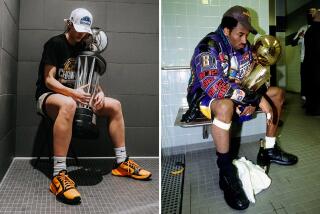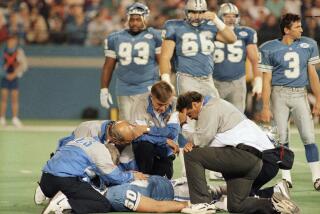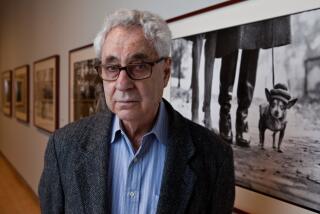Morris Berman, 92; Tittle Photo Endures
Morris Berman, the Pittsburgh newspaper photographer whose photo of bloodied New York Giants quarterback Y.A. Tittle became one of the most enduring images in sports, has died. He was 92.
Berman died Sunday in Sun City, Ariz., of congestive heart failure.
For the record:
12:00 a.m. June 22, 2002 For The Record
Los Angeles Times Saturday June 22, 2002 Home Edition Main News Part A Page 2 National Desk 7 inches; 259 words Type of Material: Correction
Museum location--An obituary of photographer Morris Berman in Friday’s California section incorrectly stated that the West Valley Art Museum, where Berman had an exhibition, is in Sunrise, Ariz. It is in Surprise, Ariz.
A newspaper photographer in Pittsburgh for more than 40 years, Berman always maintained that his photo of Tittle would have won a Pulitzer Prize--if his newspaper had only printed it.
Berman was working for the Pittsburgh Post-Gazette in 1964 when he was assigned to cover an early season NFL game between the Pittsburgh Steelers and the visiting Giants.
In an interview with the Phoenix New Times last year, Berman said he decided to focus on one player as the game went along and that player was Tittle.
“I thought if I followed somebody at the heart of things, I might be able to get something,” he said.
In a series of photographs, Berman recorded Steeler defensive end John Baker breaking through the line and pounding Tittle to the turf as the quarterback tried to throw. The pass, intended for running back Frank Gifford, was intercepted by the Steelers and returned for a touchdown. Tittle, then 37, was badly shaken on the play and suffered bruised ribs. He sat out the second half of the game, which the Steelers won 27-24.
Tittle retired at the end of that season.
While other photographers recorded Baker’s hit and Tittle as he was later helped to his feet by teammates, Berman was apparently the only one to capture Tittle alone, battered and bleeding and sitting back on his knees.
Berman took the film back the paper and showed his photo editor, who declined to run it the next day because, he said, there was no action in the photograph. He did, however, run several other Berman photographs of the game. All were standard fare.
Despite his photo editor’s negative response, Berman liked the Tittle photograph and began entering it in professional competitions. Others liked it too; it won several awards, including a National Headliner prize as the best sports photograph of 1964.
It has been included in collections of the best sports photographs of the 20th century and now hangs in the National Football Hall of Fame in Canton, Ohio. It was also part of an HBO documentary on sports photography last January called “Picture Perfect: The Stories Behind the Greatest Photographs in Sports,” produced by Neil Leifer and Joe Lavine.
The picture was not only an aesthetic success--capturing Tittle’s failed last stand in the brutal world of pro football--but also helped change the way photographers looked at sports. While action shots were still a staple in newspapers and sports magazines, more subtle images that went beyond the action genre started to emerge.
“It said to a lot of people that sometimes the most revealing sports photograph was made after the play was done or the game was over. It capitalized on the value of its emotion,” said Rich Clarkson, former director of photography at National Geographic, who now has his own sports photography agency in Denver.
“It led other photographers to open their eyes to things other than peak action,” Clarkson said.
The son of Jewish immigrants from Bucharest, Berman grew up in Wheeling, W.Va. He began his newspaper career at the Wheeling News as a reporter but became interested in photography and started taking pictures to go with his stories.
After moving to Pittsburgh, he joined the staff of the now-defunct Sun-Telegraph.
His introduction to news photography in Pittsburgh came when he was given a Speed Graphic camera and assigned to cover a nasty steel strike in Beaver Falls, Pa.
Berman came back from that assignment with some memorable images and his days as a reporter were over.
During World War II, Berman served as an Army photographer in North Africa and Italy. One of his more notable images was that of the bodies of the Italian dictator Benito Mussolini and Mussolini’s mistress, Clara Petacci, after they had been strung up by their heels by an angry mob in 1945.
Back in Pittsburgh after the war, Berman continued to work for the Sun-Telegraph until it was bought by the Post-Gazette in 1960.
He stayed with the Post-Gazette until his retirement in 1979. He then moved to Arizona, where he took freelance assignments and taught at Arizona State University.
Berman was also a founding member of the National Press Photographers Assn.
An exhibition containing 80 of his photographs was shown at the West Valley Art Museum in Sunrise, Ariz., in late 2000 and early 2001. Many of the images were later shown at the Sky Harbor International Airport in Phoenix.
Berman is survived by his second wife, Diana, and several nieces and nephews.
More to Read
Go beyond the scoreboard
Get the latest on L.A.'s teams in the daily Sports Report newsletter.
You may occasionally receive promotional content from the Los Angeles Times.










